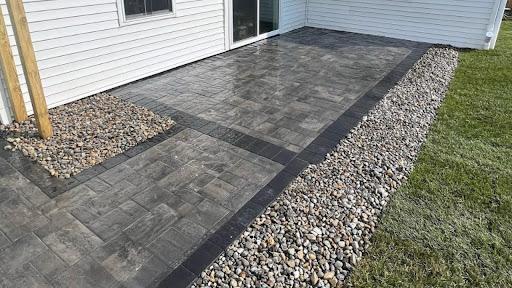BLOGS

Planning For A Paver Patio
When planning for a paver patio, start by choosing a location and design that complements your space. Measure the area to determine the amount of materials needed and prepare the ground by excavating and leveling. Install a base layer of gravel and sand for stability, then lay the pavers in your desired pattern, ensuring proper spacing and alignment. Finally, fill the joints with sand, compact the pavers, and clean the area for a finished look.
A well-planned paver patio is a key element of effective hardscaping, transforming your outdoor space into an inviting area for relaxation, entertainment, and dining. When planning for a paver patio, several essential factors need to be considered, such as design, materials, and budgeting.
At Freedom Landscaping, we specialize in creating stunning and durable paver patios tailored to your needs. This article outlines everything you need to know to achieve the perfect patio with expert tips and guidance from our team.
Key Takeaways:
Measure your space and plan your patio design carefully.
Factor in local building codes and potential permit requirements.
Budget for materials, labor, and additional features.
Decide between a DIY project or hiring professionals.
Select the appropriate paver type and prepare the foundation meticulously.
Consider enhancing your patio with additional features like planters or outdoor lighting.
Design and Planning For Paver Patio
Determine Size and Shape:
The initial step in planning your paver patio is to assess the space where it will be installed. Accurate measurements ensure that your patio is appropriately sized for its intended use and fits well within your landscape.
Dining Patio: For a dining area, aim for a space approximately 12 feet by 8 feet. This size comfortably accommodates a dining set and provides space for movement.
Walkways: For walkways, plan for a width between 36 to 48 inches. This width allows for easy passage and prevents congestion.
Visual Plan:
Creating a visual layout of your patio helps you better understand how it will integrate with your existing landscape and aids in planning the materials needed.
Sketch Your Design: Draw a layout of the patio area, including any additional features like seating or planters. This helps visualize the final appearance.
Use a Paver Calculator: Estimate the number of pavers and materials required by inputting your dimensions into a paver calculator. This tool ensures you order the right quantity and avoid shortages.
Consider Local Regulations:
Understanding local building codes and regulations is crucial to ensure your patio project complies with all necessary guidelines and avoid any potential issues.
Check Permits: Some areas may require permits for patio installation. Verify with your local building department or homeowners association (HOA) before starting.
HOA Guidelines: If you live in a community with an HOA, review their guidelines to ensure your patio design adheres to any aesthetic or structural requirements.
Budgeting For Paver Patio
Estimate Costs
Calculating the total costs for your paver patio project is crucial for effective budgeting. This involves accounting for all expenses, including materials, labor, and any additional features.
Materials: Determine the cost of pavers, base materials (gravel and sand), and any additional items like edging or sealing products.
Labor: If hiring professionals, get quotes from multiple contractors to compare rates. Include costs for installation and any additional services.
Tools and Permits: Consider the cost of renting or purchasing tools if you're DIY-ing. Factor in permit fees if required.
Additional Features: Budget for extras like outdoor lighting, furniture, or landscaping enhancements to avoid unexpected costs.
DIY vs. Hiring Professionals
Choosing between DIY and professional installation impacts both the cost and quality of your paver patio. Evaluate your options based on your budget and project scope.
DIY Approach: This can save money but requires time, effort, and a certain level of skill. Ensure you have the necessary tools and knowledge to complete the project.
Professional Services: Hiring experts guarantees high-quality results and efficiency but comes at a higher cost. Professionals handle all aspects of the installation, ensuring a polished finish.
Phased Approach
If budget constraints are a concern, breaking the project into phases allows for better financial management while still progressing towards your final goal.
Initial Phase: Start with the essential base structure and necessary groundwork. This sets a solid foundation for future additions.
Subsequent Phases: Complete additional elements such as features or landscaping in stages as your budget allows. This approach helps manage costs and allows for adjustments based on your needs and preferences.
Materials Selection For Paver Patio
Choose Paver Type
Your choice of pavers will influence the aesthetic and functionality of your patio. Consider the following options:
Concrete Pavers: Durable and versatile, available in many colors.
Brick Pavers: Smaller, traditional, and adaptable to various designs.
Flagstone or Slate: Offers a natural look but may require more precise planning.
Travertine: Reflects heat, making it ideal for sunny climates.
Base Materials
The foundation is crucial to your patio’s longevity. Use 4-6 inches of gravel as a base layer, followed by 1 inch of polymeric sand to secure the pavers and prevent shifting.
Installation Steps For Paver Patio
Excavation: Remove about 8-10 inches of soil to make room for the base and pavers. Ensure the area is level to create a sturdy foundation.
Base Layer Preparation: Lay down the gravel and compact it tightly to ensure proper drainage and stability. This step is crucial for preventing water buildup and foundation movement.
Laying Pavers: Begin laying your pavers at one edge, making sure they’re level and well-aligned. Use edging materials to keep the pavers from shifting.
Joint Filling: Fill gaps between the pavers with polymeric sand. This not only locks the pavers in place but also prevents weed growth and insects.
Final Touches: To enhance your patio, consider adding planters, outdoor lighting, or furniture. These elements can transform a basic patio into a cozy and functional outdoor living space.
The Benefits of a Hardscaped Outdoor Living Space
Hardscaping integrates non-living elements such as patios, pathways, and retaining walls into your landscape, enhancing both the visual appeal and functionality of your outdoor area. It creates defined spaces for various activities and offers numerous advantages over traditional lawns.
Aesthetic Appeal: Hardscape elements like elegant patios and stylish pathways improve the overall look of your outdoor space.
Functional Zones: Design distinct areas for dining, lounging, or gardening, making your outdoor space more versatile.
Low Maintenance: Compared to lawns, hardscaped areas require less upkeep, saving time and effort.
Increased Property Value: Well-designed hardscape features can enhance your property's value and appeal to potential buyers.
Durability: Hardscape elements such as patios and outdoor kitchens offer long-lasting solutions that extend your living space outdoors.
Choosing the Right Materials for Your Patio
Selecting appropriate materials is crucial for achieving the desired aesthetics and durability of your patio. Each material has its own benefits and considerations, influencing the overall success of your project.
Concrete Pavers: Affordable and available in various colors and styles, making them a versatile option for many designs.
Brick Pavers: Offer a classic, timeless look with a rustic charm but require precise installation to ensure durability.
Natural Stones: Options like flagstone or slate add a sophisticated and unique touch but can be more costly and irregular in shape.
Climate Considerations: Choose materials that withstand your local weather conditions to ensure longevity and performance.
Intended Use and Budget: Balance your choice based on how you plan to use the patio and your budget constraints to get the best value for your investment.
Frequently Asked Questions About Pavers Patios
What is the best base for a paver patio?
For hardscaping projects like a paver patio, the best base consists of 4-6 inches of compacted gravel, followed by 1 inch of polymeric sand. This ensures a stable and well-draining foundation that supports the longevity and durability of the patio.
How do you prepare the ground for patio pavers?
When preparing the ground for a hardscaping project such as a paver patio, excavate to a depth of about 8-10 inches. Level and compact the soil, then lay a layer of gravel and compact it. Finish by spreading 1 inch of sand on top to create a smooth surface for the pavers.
What is the proper spacing for pavers?
In hardscaping, the proper spacing for pavers is typically 1/8 to 1/4 inch apart. This gap is essential for filling with joint sand, which helps keep the pavers aligned and stable over time.
How to lay a patio for beginners?
For beginners tackling a hardscaping project like laying a paver patio, start by excavating and preparing the ground. Install a gravel base and a sand layer, then arrange the pavers in your chosen pattern, ensuring each is level and aligned. Complete the process by filling the gaps with polymeric sand and compacting the surface.
How do you start a paver pattern?
When starting a paver pattern in a hardscaping project, begin by laying pavers along a straight edge or border. This reference line helps maintain alignment and consistency throughout the rest of the patio installation.
Creating Your Dream Patio with Freedom Landscaping
Designing and installing a paver patio is an investment in your outdoor living space that pays off in beauty, function, and value. Whether you opt for a DIY project or hire professionals, careful planning and attention to detail will ensure a stunning result. Freedom Landscaping LLC is here to help make your dream patio a reality. Our expert team offers top-notch hardscaping services tailored to your needs.
With our commitment to quality and customer satisfaction, we guarantee a seamless experience from start to finish. Contact us now to schedule a consultation and start planning your perfect patio today!
Ready To Give Your Property The Love It Deserves?
Whether it is keeping your lawn professionally maintained or completely re-vamping the look of your landscape, let our team of professional landscapers at Freedom Landscaping take your property to a whole new level!
Contact Us
Mon - Sat: 7:00 am - 6:00 pm
Sunday: Closed
© 2024 Freedom Landscaping LLC. All Rights Reserved. Privacy Policy. Terms & Conditions. Web Design By Fused Media.


